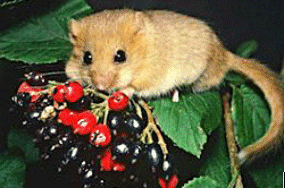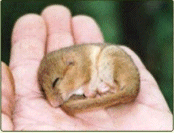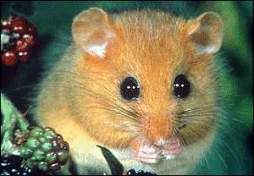THE HAZEL DORMOUSE

The hazel dormouses Latin name avellanarius means 'hazel'.
 The
Hazel Dormouse is the only small mammal in Britain to have a completely furry
tail. They have golden-brown fur and large black eyes and are nocturnal creatures
spending most of their waking hours high among the branches of trees looking
for food. They will make long detours through the treetops rather than come
down to the ground and expose themselves to danger.
The
Hazel Dormouse is the only small mammal in Britain to have a completely furry
tail. They have golden-brown fur and large black eyes and are nocturnal creatures
spending most of their waking hours high among the branches of trees looking
for food. They will make long detours through the treetops rather than come
down to the ground and expose themselves to danger.
From early October dormice hibernate in nests beneath the leaf litter on the forest floor. When they wake up in spring (late April or early May), they build woven nests of shredded honeysuckle bark, fresh leaves and grasses in the undergrowth. If the weather is cold and wet, and food scarce, they save energy by going into torpor; they curl up into a ball and go to sleep. Dormice, therefore, spend a large proportion of their lives sleeping; either hibernating in winter or in torpor in summer.
Identification signs
Examination of hazel nuts may show a neat round hole in the shell. This indicates that it has been opened by a small rodent, e.g. the dormouse, Wood mouse, or Bank vole. Other animals such as squirrel or jay will either split the shell completely in half or make a jagged hole in it. Further examination reveals that the inner rim of the hole has toothmarks which are at an angle to the hole for the dormouse.
Diet
- It feeds on a wide variety of aboreal foods:
- flowers for nectar and pollen
- fruits - berry and nuts
- insects - especially aphids and caterpillars
- buds of young leaves
- Hazel - the main food for fattening up before hibernation, although the tree is also an important provider of insects.
- Hornbeam and blackthorn fruit where hazel is scarce
A variety of different food sources available at different times of year is required to ensure the hazeldormouse survives.
Habitat
Woodland and hedgerows that are species rich and connected to woodland. Ideally they are 3 to 4 metres high, and left at least 7 years before cutting - because many shrubs do not begin to fruit until that time period has passed.
They usually only travel less than 70 metres from their nest.
Trees and shrubs of value to dormice:
- Hazel - principal food source, supports insects. Forms an understory of poles, especially when coppiced, which makes it useful for its arboreal activity.
- Oak - insect and flower food. Acorns of little value.
- Honeysuckle - bark is nesting material. Flowers and fruit are food.
- Bramble - flowers and fruits provide food over a long period. Thorns give protection for nests. Dormice thrive on blackberries.
- Sycamore - insect and pollen, and a habitat. However they cast a dense shade which decreases the understory.
- Ash - seed keys whilst they are still on the tree.
- Viburnum lantana - fruits and flowers.
- Yew - fruits are a favoured food.
- Hornbeam - seeds.
- Broom - flowers (in early Summer).
- Sallow - unripe seeds, supports many insects.
- Birch - seeds.
- Sweet chestnut - chestnut an excellent foodsource, the flowers are eaten as well.
- Blackthorn - Fruits are eaten.
- Hawthorn - flowers are an important food in the spring. Fruit eaten occasionally.
Threats
- Predation from Eurasian badger, fox, stoat, weasel
- Trampling, e.g. deer, human
- Lack of food source e.g from too frequent hedge-trimming, or competition from other species e.g. squirrel
- Destruction of forest and hedge-row habitat, or their diverse range of species as a broad spectrum of food is required across the calendar year.
